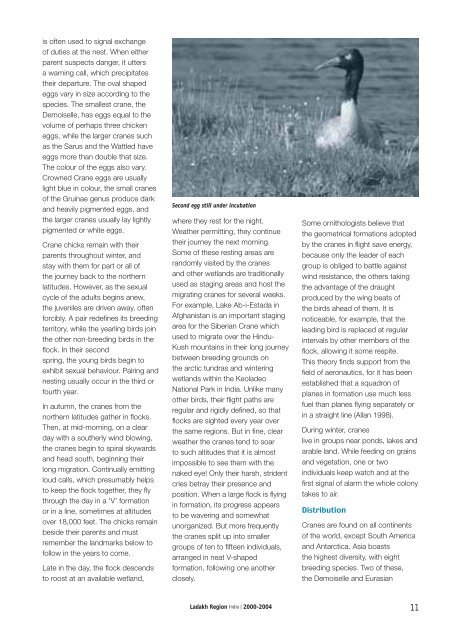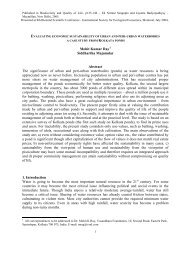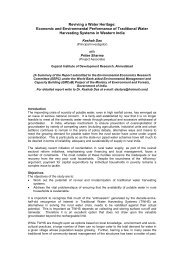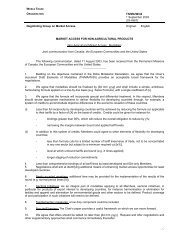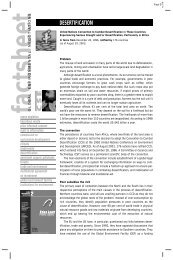Black-necked Crane - WWF-India
Black-necked Crane - WWF-India
Black-necked Crane - WWF-India
You also want an ePaper? Increase the reach of your titles
YUMPU automatically turns print PDFs into web optimized ePapers that Google loves.
is often used to signal exchange<br />
of duties at the nest. When either<br />
parent suspects danger, it utters<br />
a warning call, which precipitates<br />
their departure. The oval shaped<br />
eggs vary in size according to the<br />
species. The smallest crane, the<br />
Demoiselle, has eggs equal to the<br />
volume of perhaps three chicken<br />
eggs, while the larger cranes such<br />
as the Sarus and the Wattled have<br />
eggs more than double that size.<br />
The colour of the eggs also vary.<br />
Crowned <strong>Crane</strong> eggs are usually<br />
light blue in colour, the small cranes<br />
of the Gruinae genus produce dark<br />
and heavily pigmented eggs, and<br />
the larger cranes usually lay lightly<br />
pigmented or white eggs.<br />
<strong>Crane</strong> chicks remain with their<br />
parents throughout winter, and<br />
stay with them for part or all of<br />
the journey back to the northern<br />
latitudes. However, as the sexual<br />
cycle of the adults begins anew,<br />
the juveniles are driven away, often<br />
forcibly. A pair redefi nes its breeding<br />
territory, while the yearling birds join<br />
the other non-breeding birds in the<br />
fl ock. In their second<br />
spring, the young birds begin to<br />
exhibit sexual behaviour. Pairing and<br />
nesting usually occur in the third or<br />
fourth year.<br />
In autumn, the cranes from the<br />
northern latitudes gather in fl ocks.<br />
Then, at mid-morning, on a clear<br />
day with a southerly wind blowing,<br />
the cranes begin to spiral skywards<br />
and head south, beginning their<br />
long migration. Continually emitting<br />
loud calls, which presumably helps<br />
to keep the fl ock together, they fl y<br />
through the day in a ‘V’ formation<br />
or in a line, sometimes at altitudes<br />
over 18,000 feet. The chicks remain<br />
beside their parents and must<br />
remember the landmarks below to<br />
follow in the years to come.<br />
Late in the day, the fl ock descends<br />
to roost at an available wetland,<br />
Second egg still under incubation<br />
where they rest for the night.<br />
Weather permitting, they continue<br />
their journey the next morning.<br />
Some of these resting areas are<br />
randomly visited by the cranes<br />
and other wetlands are traditionally<br />
used as staging areas and host the<br />
migrating cranes for several weeks.<br />
For example, Lake Ab-i-Estada in<br />
Afghanistan is an important staging<br />
area for the Siberian <strong>Crane</strong> which<br />
used to migrate over the Hindu-<br />
Kush mountains in their long journey<br />
between breeding grounds on<br />
the arctic tundras and wintering<br />
wetlands within the Keoladeo<br />
National Park in <strong>India</strong>. Unlike many<br />
other birds, their fl ight paths are<br />
regular and rigidly defi ned, so that<br />
fl ocks are sighted every year over<br />
the same regions. But in fi ne, clear<br />
weather the cranes tend to soar<br />
to such altitudes that it is almost<br />
impossible to see them with the<br />
naked eye! Only their harsh, strident<br />
cries betray their presence and<br />
position. When a large fl ock is fl ying<br />
in formation, its progress appears<br />
to be wavering and somewhat<br />
unorganized. But more frequently<br />
the cranes split up into smaller<br />
groups of ten to fi fteen individuals,<br />
arranged in neat V-shaped<br />
formation, following one another<br />
closely.<br />
Some ornithologists believe that<br />
the geometrical formations adopted<br />
by the cranes in fl ight save energy,<br />
because only the leader of each<br />
group is obliged to battle against<br />
wind resistance, the others taking<br />
the advantage of the draught<br />
produced by the wing beats of<br />
the birds ahead of them. It is<br />
noticeable, for example, that the<br />
leading bird is replaced at regular<br />
intervals by other members of the<br />
fl ock, allowing it some respite.<br />
This theory fi nds support from the<br />
fi eld of aeronautics, for it has been<br />
established that a squadron of<br />
planes in formation use much less<br />
fuel than planes fl ying separately or<br />
in a straight line (Allan 1998).<br />
During winter, cranes<br />
live in groups near ponds, lakes and<br />
arable land. While feeding on grains<br />
and vegetation, one or two<br />
individuals keep watch and at the<br />
fi rst signal of alarm the whole colony<br />
takes to air.<br />
Distribution<br />
<strong>Crane</strong>s are found on all continents<br />
of the world, except South America<br />
and Antarctica. Asia boasts<br />
the highest diversity, with eight<br />
breeding species. Two of these,<br />
the Demoiselle and Eurasian<br />
Ladakh Region <strong>India</strong> | 2000-2004 11


